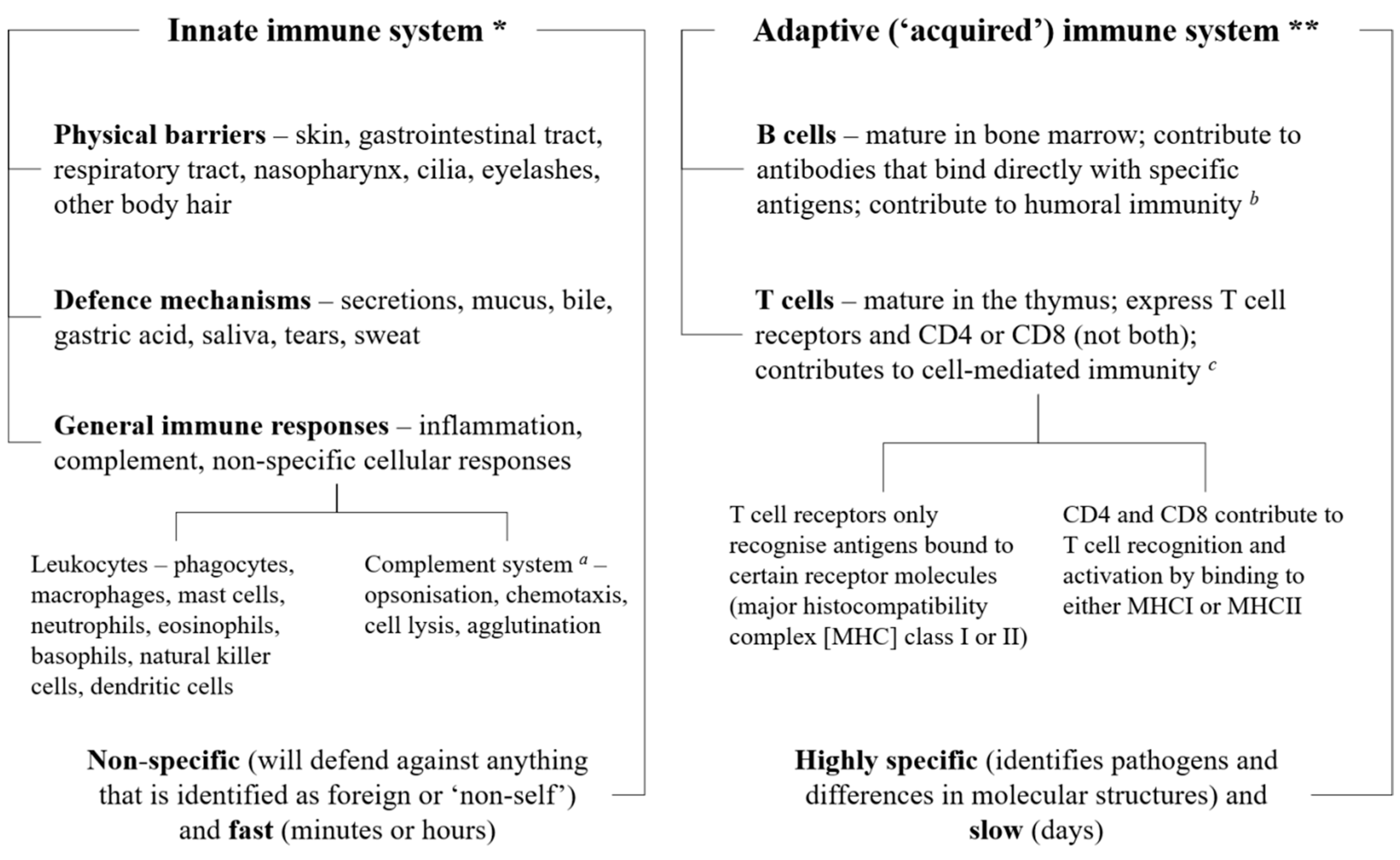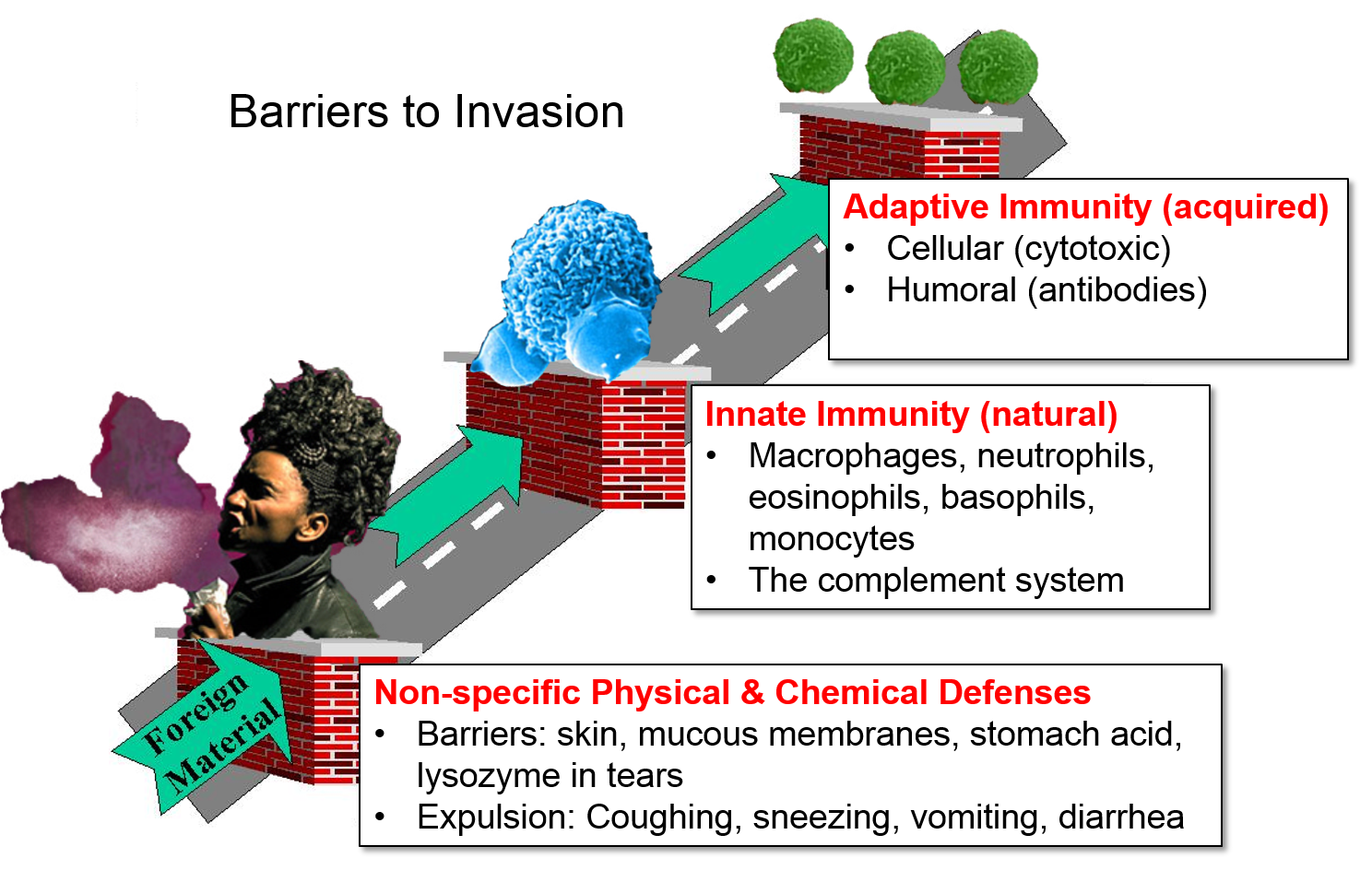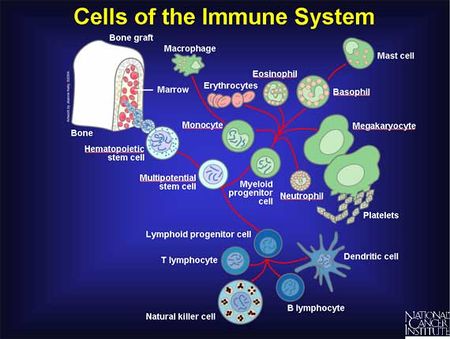Elements of the Immune System and Their Roles in Defense
The cells and tissues that recognize and attack foreign substances in the body. The immune systems three lines of defense include physical and chemical barriers non-specific innate responses and specific adaptive responses.

Nutrients Free Full Text Immune Function And Micronutrient Requirements Change Over The Life Course Html
Your body has three different lines of defense against.

. Each cell type either circulates in. April 30 2019. As these stem cells can give rise to all of the different types of blood cells they.
T-cells can either directly destroy the microbes or use chemical secretions to destroy them. Community of microbes inhabiting a particular niche in the body. The Immune System has 3 Lines of Defense Against Foreign Pathogens.
The phagocytes of the immune system engulf other particles or cells either to clean an area of debris old cells or to kill pathogenic organisms such as bacteria. If the immune system is a police force the bone marrow is the police academy because this is where the different types of immune system cells are created. The innate the adaptive and the acquired immune systems.
Theory Review Questions - STUDY GUIDE Lecture 1. First line of defense. Immune system provides resistance to disease Made up of two intrinsic systems.
The main job of the innate immune system is to fight harmful substances and germs that enter the body for instance through the skin or digestive system. Here we explain how it works and the cells organs. Explain their role in development maturation and selection of B and T cells.
Bone marrow primary lymphoid tissue site where most cells undergo development differentiation and maturation except T cells. The primary parts of the immune system include the bone marrow and thymus. Antigenic determinant site - parts of antigen that stimulates an immune response 4.
Natural killer NK cells also are derived from the common lymphoid progenitor and share features of both innate and adaptive immune cells as they provide immediate defenses like innate cells but also may be retained as memory cells like adaptive cells. Nonspecific Resistance Innate Immunity. The immune system defends the body against infectious agents and other internal and external insults.
The immune system consists of many parts that work together to defend the body against invaders. It mostly fights using immune cells such as natural killer cells and phagocytes eating cells. The immune system defends our body against invaders such as viruses bacteria and foreign bodies.
Each of these elements plays a key role in how the immune system works and its function as a whole which is crucial. All the cellular elements of blood including the red blood cells that transport oxygen the platelets that trigger blood clotting in damaged tissues and the white blood cells of the immune system derive ultimately from the same progenitor or precursor cellsthe hematopoietic stem cells in the bone marrow. There are many white blood cell types in your immune system.
3 Lines of Defense 1. The immune defense system comprises a combination of anatomic physical barriers including the skin mucous membranes mucous blanket and ciliated epithelial cells. Learn vocabulary terms and more with flashcards games and other study tools.
The immune system is the bodys natural defense system. Immunity due to antibodies and their actions. The Bodys Defenses Against Infection.
Elements of the immune system and their roles in defense. Activation of a helper T cell and its roles in immunity. ELEMENTS OF THE INNATE IMMUNE SYSTEM.
Innate Immunity the Immediate Response to Infection. B T and NK cells also are called lymphocytes. The acquired immune system with help from the innate system makes special proteins called antibodies to protect your body from a specific invader.
In contrast to the adaptive immune system which. Organs and tissues important to the proper functioning of the immune system include the thymus and bone marrow lymph nodes and vessels spleen and skin. Innate nonspecific defense system.
If these are evaded the components of the immune system are quickly activated to protect the. The immune systems lines of defense are comprised of three major components. The most important function of antibodies is to facilitate engulfment and destruction of extracellular microorganisms and toxins by phagocytes.
Antimicrobial proteins phagocytes and other cells inhibit spread of invaders. Antibody binding to pathogen such that it inhibits pathogen growth replication or interaction with human cells. Elements of the Immune system and their Role in Defense Q-1 List the primary lymphoid organs of our immune system.
The Immune System Fourth Edition emphasizes the human immune system and presents immunological concepts in a coherent concise and contemporary account of how the immune system works. The immune system protects its host from infection with layered defenses of increasing specificity. Nonspecific cellular defenses 1.
Antibody Structure and the Generation of B-Cell Diversity. Antigen Recognition by T Lymphocytes. White blood cells are a key part of your immune system.
Immunity if defined broadly encompasses all mechanisms and responses used by the body to defend itself against foreign substances microorganisms toxins and noncompatible living cellsSuch immunity may be conferred by the immune system itself or by the protective role of other generalized host defensive mechanisms. The invader is killed inside the immune system cells called phagocytes. Physical and Chemical Barriers Innate Immunity 2.
Start studying Chapter 1. The acquired immune system. The main parts of the immune system are.
The cells of this immune system surround and cover the invader. If a pathogen breaches these barriers the innate immune system provides an immediate but non-specific response. Bone marrow and thymus.
Macrophages neutrophils Feed on pathogens that penetrate membrane barriers Display antigen to enhance immune response specific response 2. Elements of the Immune System Their Roles in Defense. Constitutes firstand second lines of defense.
The Development of T Lymphocytes. The phagocytes are the bodys fast acting first line of immunological defense against organisms that have breached barrier defenses and have entered the vulnerable tissues of the body. The adaptive specific immune system makes antibodies and uses them to specifically fight certain germs.
The bone marrow is. Usually foreign to body. Physical barriers prevent pathogens such as bacteria and viruses from entering the organism.
2nd line of Nonspecific defense. Elements of the Immune System and their Roles in Defense. The white blood cells are a key component.
The Development of B Lymphocytes. Disruption of Healthy Tissue by. It does not reside in one single part of the bodyrather it is made up of a network of cells molecules tissues and organs working together to protect the body.
External body membranes skin and mucosae Second line of defense. Elements of the Immune System and their Roles in Defense. Serving as an army against harmful bacteria and viruses white blood cells search for attack and destroy germs to keep you healthy.
Immunity Mediated by B cells and Antibodies.

Biological Defense Mechanisms That Protect The Body The Immune System Download Scientific Diagram

Cellular Components Of The Mammalian Immune System The Mammalian Download Scientific Diagram


No comments for "Elements of the Immune System and Their Roles in Defense"
Post a Comment